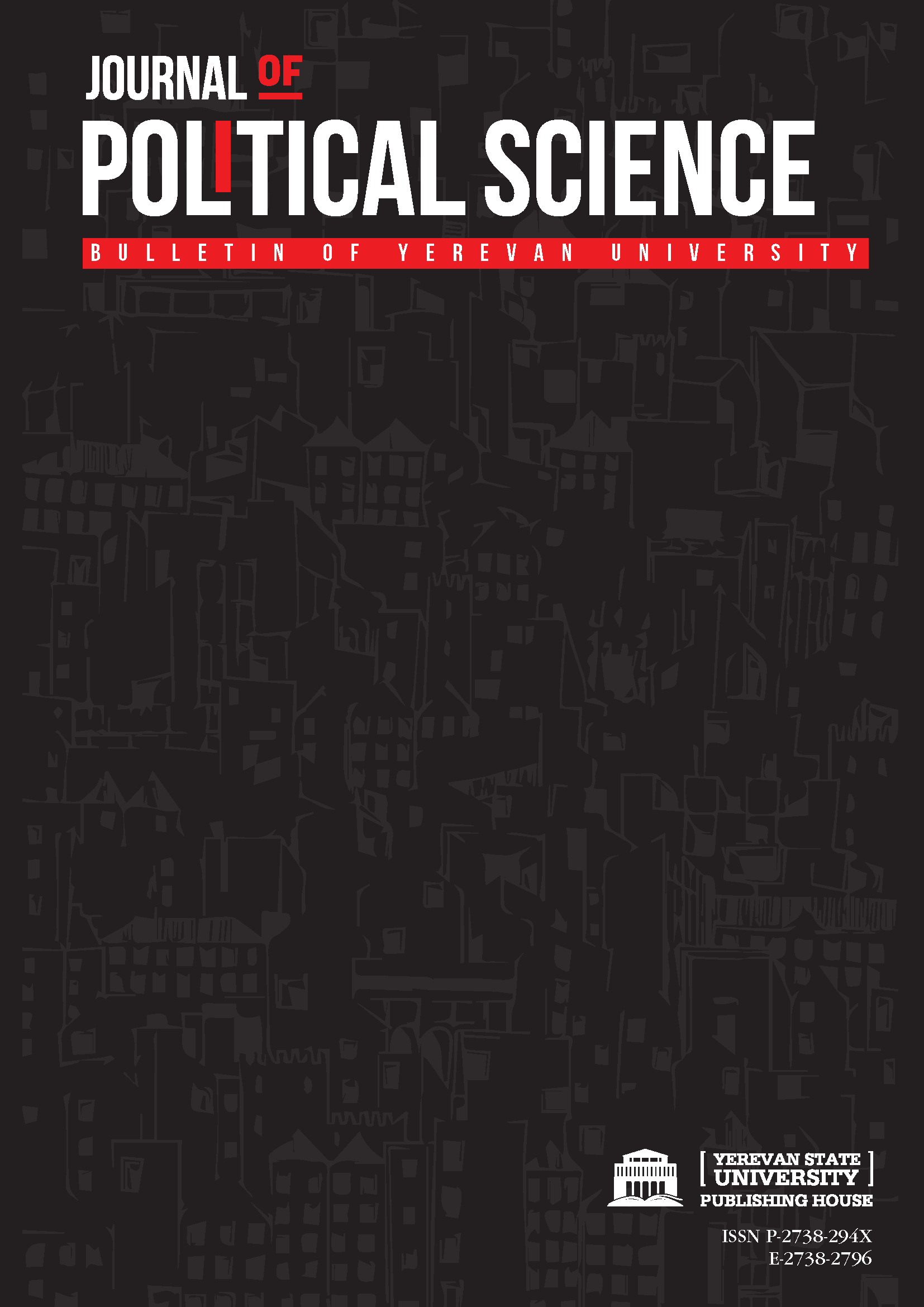On the Issues of Social Movements in Armenia։ Civic Influence or a Step Towards Democratization?
DOI:
https://doi.org/10.46991/JOPS/2022.1.1.107Keywords:
human rights, citizenship, civic activism, social movements, democratization, post-communist countries, Armenia, accountability, transparencyAbstract
Social movements in Armenia are a topical subject of political science analysis by both world, regional and Armenian researchers. Scientific interest in Armenia in this topic of social movements and civic influence arose in the late 1980s and early 1990s, when democratization began in the political life of the Armenian society. In this article, social movements are analyzed as an organized structure of actions, which is endowed with certain democratic resources, presence in a public environment, special knowledge and skills that allow effective communication with public authorities in order to resolve this discontent. From this boiling point, social movements represent an integral element of the democratic regime of the political system of the Armenian transformational society. Public movements in Armenia are a mechanism for expressing the point of view of representatives of civil society, a way of highlighting in the public space those discontent that arise in society, a way of citizens’ participation in politics, and not just in the period between elections. The article focuses on the fact that social movements in Armenia can also be viewed as a democratic resource that should be more effectively cooperated with the authorities, the ruling party and other parliamentary parties for a civilized solution of problems, in which the authorities and the civil environment are interested.
References
Aleksanyan, Ashot. 2019. “Zivilgesellschaft in Armenien und im Südkaukasus.” In: Politik und Gesellschaft im Kaukasus. Eine unruhige Region zwischen Tradition und Transformation, Hrsg. Olaf Leiße, 305-326. Springer VS: Wiesbaden. https://doi.org/10.1007/978-3-658-26374-4_14.
Aleksanyan, Ashot. 2020. “Civil Society as a Phenomenon of Post-Soviet Political Life: A Threat or a Guarantor of National Security.” In: Transformation and Development, edited by Anja Mihr, 29-49. Springer, Cham. https://doi.org/10.1007/978-3-030-42775-7_3.
Andreasyan, Zhanna, and Georgi Derlugyan. 2015. “Armenia’s Fuel Protests.” New Left Review (September/October). Accessed October 1, 2021. https://newleftreview.org/issues/ii95/articles/georgi-derluguian-zhanna-andreasyan-armenia-s-fuel-protests.
Benford, Robert D., and David A. Snow. 2000. “Framing Processes and Social Movements: An Overview and Assessment.” Annual Review of Sociology 26: 611-639. https://doi.org/10.1146/annurev.soc.26.1.611
della Porta, Donatella and Mario Diani. 2006. Social movements: an introduction. Oxford: Blackwell Publishing Ltd.
della Porta, Donatella. 2017. “Riding the wave: Protest cascades, and what we can learn from them.” In: Global Diffusion of Protest: Riding the Protest Wave in the Neoliberal Crisis, edited by Donatella della Porta, 9-30. Amsterdam: Amsterdam University Press B.V. https://doi.org/10.5117/9789462981690.
Ekiert, Grzegorz, Jan Kubik, and Milada Anna Vachudova. 2007. “Democracy in the Post-Communist World: An Unending Quest?” East European Politics and Societies 21 (1): 7-30. https://doi.org/10.1177/0888325406297170.
Hannigan, John A. 1985 “Alain Touraine, Manuel Castells and Social Movement Theory: A Critical Appraisal.” The Sociological Quarterly 26(4): 435-454. https://doi.org/10.1111/j.1533-8525.1985.tb00237.x.
Ishkanian, Armine. 2015. “Self-determined citizens? A new wave of civic activism in Armenia.” 16 June 2015. Accessed October 1, 2021. https://www.opendemocracy.net/en/selfdetermined-citizens-new-wave-of-civic-activism-in-armenia/.
Kitschelt, Herbert P. 1986. “Political Opportunity Structures and Political Protest: Anti-Nuclear Movements in Four Democracies.” British Journal of Political Science 16 (1): 57-85. https://doi.org/10.1017/S000712340000380X.
Kriesi, Hanspeter et al. 1995. New Social Movements in Western Europe: A Comparative Analysis. The Regents of the University of Minnesota.
Melucci, Alberto. 1989. Nomads of the Present: Social Movements and Individual Needs in Contemporary Culture. London: Hutchinson Radius.
Melucci, Alberto. 1995. “The Process of Collective Identity.” In Social Movements and Culture, edited by Hank Johnston and Bert Klandermans, 41-63. University of Minnesota Press. http://www.jstor.org/stable/10.5749/j.ctttt0p8.6.
Rhomberg, Chris, and Steven Lopez. 2021. “Understanding Strikes in the 21ST Century: Perspectives from the United States.” In: Power and Protest (Research in Social Movements, Conflicts and Change, Vol. 44), edited by Lisa Leitz, 37-62. Bingley: Emerald Publishing Limited. https://doi.org/10.1108/S0163-786X20210000044005.
Tarrow, Sidney. 1998. Power in Movement: Social Movements and Contentious Politics. Cambridge: Cambridge University Press. https://doi.org/10.1017/CBO9780511813245.
Tilly, Charles, Castañeda, Ernesto and Lesley J. Wood. 2020. Social Movements, 1768-2018. New York: Routledge. https://doi.org/10.4324/9780429297632
Downloads
Published
Issue
Section
License
Copyright (c) 2022 Olga Azatyan

This work is licensed under a Creative Commons Attribution-NonCommercial 4.0 International License.



